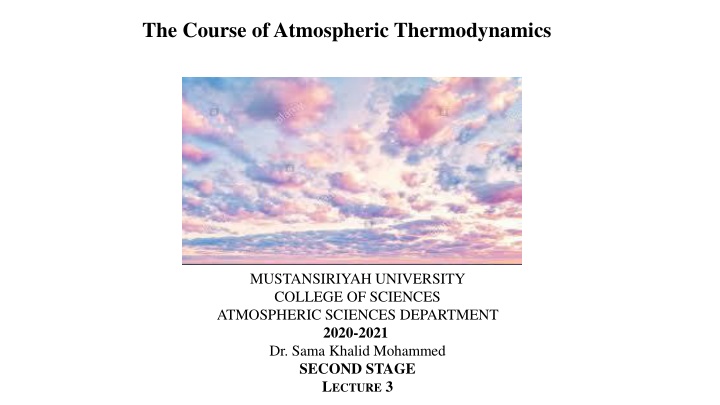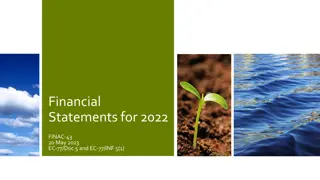
Atmospheric Thermodynamics Lecture: Virtual Temperature and Wet Bulb Concepts
Explore the key concepts of virtual temperature and wet bulb temperature in atmospheric thermodynamics. Learn about the virtual temperature as a measure of moisture content in moist air and the significance of wet bulb temperature in humidity measurement. Dive into the relationships between these parameters and their implications for atmospheric stability.
Download Presentation

Please find below an Image/Link to download the presentation.
The content on the website is provided AS IS for your information and personal use only. It may not be sold, licensed, or shared on other websites without obtaining consent from the author. If you encounter any issues during the download, it is possible that the publisher has removed the file from their server.
You are allowed to download the files provided on this website for personal or commercial use, subject to the condition that they are used lawfully. All files are the property of their respective owners.
The content on the website is provided AS IS for your information and personal use only. It may not be sold, licensed, or shared on other websites without obtaining consent from the author.
E N D
Presentation Transcript
The Course of Atmospheric Thermodynamics MUSTANSIRIYAH UNIVERSITY COLLEGE OF SCIENCES ATMOSPHERIC SCIENCES DEPARTMENT 2020-2021 Dr. Sama Khalid Mohammed SECOND STAGE LECTURE 3
This lecture including the following items VIRTUAL TEMPERATURE Wet Bulb Temperature Tw Wet Bulb Depression POTENTIAL TEMPERATURE DRY AIR DEFINITION STABILITY OF DRY AIR / DRY ADIABATIC LAPSE RATE BUOYANCY STABILITY IN A DRY ATMOSPHERE The Saturated Adiabatic Lapse Rate Stability of Saturated Air
VIRTUAL TEMPERATURE Moist air can be considered a mixture of two ideal gases (dry air and water vapor). The ideal gas law for moist air is By manipulate the above equation , we can define a new temperature, Tv ( the virtual temperature) For moist air we can use the ideal gas law for dry air, only using the virtual temperature in place of the actual temperature. The virtual temperature is the temperature that dry air would have if its density were equal to that of a given sample of moist air at constant pressure , and it can be expressed as: Tv= (1 + 0.61 q ) T Virtual temperature is always greater than or equal to the actual temperature.
VIRTUAL TEMPERATURE The addition of water vapor causes the air to behave as though it is warmer. This makes sense, because moist air is lighter than dry air. we can write virtual temperature using mixing ratio as Tv (1 + 0.61 r ) In all of the preceding equations for virtual temperature we must use the absolute (Kelvin) temperature and the dimensionless form of mixing ratio or specific humidity. However, there is an approximate formula for virtual temperature in Celsius that uses the dimensional (g/kg) form of mixing ratio or specific humidity. This formula is Tv ( C ) T ( C) +r (g/kg) 6
Wet Bulb Temperature Tw Meteorologists commonly measure humidity by measuring the wet-bulb temperature. The wet-bulb temperature is the lowest temperature that can be achieved by evaporating water into the air parcel at constant pressure (the evaporation requires heat, which is supplied by the air parcel). It is measured using A PSYCHROMETER.
Wet Bulb Depression The difference between the air temperature (dry-bulb temperature) and the wet-bulb temperature is called WET-BULB DEPRESSION The wet-bulb depression is a relative measure of the moisture content of the air. Dry air can be cooled much further by evaporation than moist air, so a larger wet-bulb depression means less humidity (for the same dry-bulb temperature). FYI: The dew-point temperature and relative humidity are found by using psychrometric tables, with dry-bulb temperature and wet-bulb depression as the independent variables ( watch this video and do the exercise using the charts in the following slides https://www.youtube.com/watch?v=yC7EMtRCqBM
FYI: THE DEW-POINT TEMPERATURE AND RELATIVE HUMIDITY The dew-point temperature and relative humidity are found by using psychrometric tables, with dry-bulb temperature and wet-bulb depression as the independent variables ( watch this video and do the exercise using the charts in the following slides, assuming T=12 C and Tw=14 C and find the relative humidity and dew point temperture. https://www.youtube.com/watch?v=yC7EMtRCqBM
FYI: The relative humidity can be found using the dry bulb temperature and wet bulb depression
FYI: The dew point can be found using the dry bulb temperature and wet bulb depression
The relative humidity can be converted to dew point depression as follows: Recall that, es So, A simple rule of thumb for converting RH to a dew point depression (T - Td) for moist air (RH >50%) is that Td decreases by 1 C for every 5% decrease in RH (starting at Td = T (dry bulb temperature), where RH = 100%). For example, if the RH is 85%, and the dew point depression is T - Td = 3 C.
POTENTIAL TEMPERATURE The potential temperature of an air parcel is the temperature that an unsaturated parcel of dry air would have if brought adiabatically from its initial state to a standard pressure, of p0 = 1000 hPa. From the Poisson relation for T and p [Eqn. (4) in course 1] we get =T p Use the equation above and find out the potential temperature for different pressure levels ( p=800,700,1016) and for temperature (T= 288 Kelvin), and you will find the same value for each level p0 Rdcp = potential temperature T = original temperature P = original pressure P0= standard pressure = 1000 hPa If an air parcel undergoes an adiabatic process its potential temperature is conserved. Rdcp = 0.2
Dry Air Definition In meteorology, there are two ways in which dry air is referenced: A sample of air that has no water vapor (The amount of water vapor in the air depends on the dewpoint of the air). A sample of air that has a low relative humidity At a temperature of 30 C with a relative humidity (RH) of 50% the dew point is 18.45 C. For drier air with temperature of 30 C and RH of 20 the dew point is 4.61 C.
Stability of Dry Air DRY ADIABATIC LAPSE RATE
Stability of Dry Air DRY ADIABATIC LAPSE RATE This formula says that if you lift an air parcel adiabatically, its temperature will decrease, which makes physical sense because the parcel will be expanding.
Stability of Dry Air DRY ADIABATIC LAPSE RATE
STABILITY IN A DRY ATMOSPHERE Stability refers to whether an air parcel, one moved vertically, will continue to accelerate in the direction that it was pushed (unstable), or return in the direction from which it came (stable).














